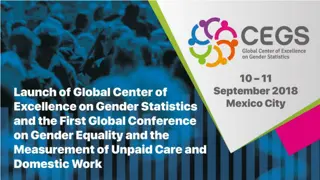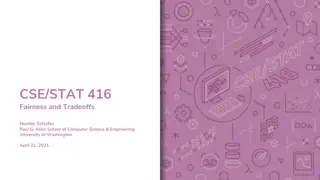Understanding Poverty, Racial Wealth Gap, and Tax Fairness
This training program is designed to review basic information on poverty, inequality, and the racial wealth gap, understand the creation and perpetuation of the racial wealth gap, learn about policy tools to narrow the gap, and empower individuals to take action towards ending hunger and poverty. The organization's approach involves creating political will, empowering individuals for personal and political power, and building engaged networks with legislators, media, and communities. They highlight the importance of addressing political priorities to combat hunger and poverty, shedding light on alarming statistics such as child poverty rates. Through advocacy and activism, they aim to make a tangible difference in communities across the country.
Uploaded on Oct 06, 2024 | 0 Views
Download Presentation

Please find below an Image/Link to download the presentation.
The content on the website is provided AS IS for your information and personal use only. It may not be sold, licensed, or shared on other websites without obtaining consent from the author. Download presentation by click this link. If you encounter any issues during the download, it is possible that the publisher has removed the file from their server.
E N D
Presentation Transcript
Care about poverty? You also need to understand the racial wealth gap and tax fairness.
Purpose This training is designed to: Review basic information on poverty, inequality, and the racial wealth gap Understand the creation and perpetuation of the racial wealth gap Learn the policy tools that can narrow the gap Answer your questions
What We Do Creating the political will to end hunger and poverty Empowering individuals to have breakthroughs in exercising personal and political power Active and engaged network that builds relationships with legislators, media and local communities
RESULTS Activists 650 active volunteers in about 100 communities around the country Everyday people who want to make a difference In 2014, our activists had Over 600 meetings with congressional offices, including 233 face-to-face meetings with U.S. House members and 60 face-to-face meetings with U.S. Senators 438 strategic media placements, including editorials, Op-eds, and letters to the editor Over 150 outreach and community events around the country In action: the story of LaNae Havens in Albuquerque
Why Do Political Priorities Matter? We stand by as children starve by the millions because we lack the will to eliminate hunger. Yet we have found the will to develop missiles capable of flying over the polar cap and landing within a few hundred feet of their target. This is not innovation. It is a profound distortion of humanity s purpose on earth. former Sen. Mark Hatfield (R-OR)
Poverty in America: 1 in 7! Based on the most recent U.S. Census data, 14.8 percent of Americans were living in poverty in 2014, or 46.7 million people. The child poverty rate was 21.1 percent of children, which amounts to 15.5 million children. CFED reports that in 2014, the asset poverty rate in the U.S. was 25 percent.
Child Poverty: Almost 1 in 5! The child poverty rate in 2014 was 21.1 percent, up from 19.9 percent in 2013.
Liquid Asset Poverty Liquid asset poverty: assets that are cash or can be converted to cash quickly More astounding is that the liquid asset poverty rate was 44 percent. This means that nearly one half of all Americans are only one financial crisis away from poverty!
Focusing on Income Alone is not Sufficient to Address Inequality
Racial Wealth Gap Quiz 1. The average top 0.1 percent of households gets how much in benefits from homeownership tax programs? A. $17,276 B. $10,276 C. $3 D. $20,500
Racial Wealth Gap Quiz 1. The average top 0.1 percent of households gets how much in benefits from homeownership tax programs? A. $17,276 The U.S. tax code spends over $540 billion per year in asset-building programs and incentives, the overwhelmingly majority of which goes to the wealthiest families. Source: http://cfed.org/assets/pdfs/Upside_Down_to_Right-Side_Up_2014.pdf
Racial Wealth Gap Quiz 1. In 2014, how much wealth did Black and Latino households own for every $1 dollar White households owned? A. A Black family held 30 cents and a Hispanic family held 20 cents B. A Black family held 6 cents and a Hispanic family held 7 cents C. A Black family held 4 cents and a Hispanic family held 7 cents D. A Black family held 50 cents and a Hispanic family held 63 cents.
Racial Wealth Gap Quiz 1. In 2014, how much wealth did Black and Latino households own for every $1 dollar White households owned? B. A Black family held 6 cents and a Hispanic family held 7 cents
An Example on Wealth Inequality Richard and Brigitte Thomas, an African American couple with two children, earned a combined income of $115,000 in 2014. In 2000, they decided to purchase a home to call their own. Their search led them to a newly constructed house with a yard, priced at $130,000. To them, this appeared to be a great opportunity.
Great Recessions Impact on Households
Racial Wealth Gap Quiz 3. As of 2013, what is the ratio of Black wealth to White wealth? A. 15:2 B. 13:1 C. 10:1 D. 9:1
Racial Wealth Gap Quiz 3. As of 2013, what is the ratio of Black wealth to White wealth? B. 13:1 This ratio has actually grown since the Great Recession. Pew Research Center points out that financial assets (stocks and investments), which White families are much more likely to own, recovered quicker than housing assets. Source: http://www.pewresearch.org/fact-tank/2014/12/12/racial-wealth-gaps-great- recession/
Racial Wealth Gap Quiz 4. How many Latino families do NOT hold financial assets? A. 1 in 5 B. 1 in 4 C. 1 in 3 D. 1 in 2
Racial Wealth Gap Quiz 4. How many Latino families do NOT hold financial assets? C. 1 in 3
Racial Wealth Gap Quiz 5. Does education have the most impact on the racial wealth disparity? A. Yes- education allows people of color to have equal access to home loans and stock options. B. Yes- Latino college graduates fare better than White high school dropouts in accumulating wealth. C. No- education fails in providing people of color with opportunity. D. No- more educational attainment alone will not significantly close the racial wealth disparity. .
Racial Wealth Gap Quiz 5. Does education have the most impact on the racial wealth disparity? D. No- more educational attainment alone will not significantly close the racial wealth disparity.
Education as the Vehicle of Opportunity? http://www.demos.org/sites/default/files/imce/Median.png A Black college graduate or a Latino college graduate, on average, owns less wealth than a White high school dropout.
Racial Wealth Gap Quiz 6. What is the single largest driver of the racial wealth gap? A. Inequities in education B. Inequities in homeownership C. Inequities in income
Racial Wealth Gap Quiz What is the single largest driver of the racial wealth gap? B. Inequities in homeownership
Racial Wealth Gap Quiz Which of the following is considered the most significant cause of the racial wealth gap? A. Lack of educational attainment. B. Racially-motivated/discriminatory public policies. C. The housing bust of 2007. D. Natural occurrences with such a diverse country.
Racial Wealth Gap Quiz Which of the following is considered the most significant cause of the racial wealth gap? B. Racially-motivated/discriminatory public policies. It is easy to assume that this wealth gap is because people just do not attain enough education, or earn enough, or that it just happened. But history shows that policies at the federal, state, and local levels (especially housing policies) explicitly or implicitly denied communities of color access to wealth building opportunities that were available to White Americans. Source: http://www.epi.org/publication/modern-segregation/
Racial Wealth Gap Quiz 9. What percentage of Black workers weren t included in the original Social Security Act created by FDR? A. 65 percent B. 50 percent C. 25 percent D. 80 percent
Racial Wealth Gap Quiz What percentage of Black workers weren t included in the original Social Security Act created by FDR? A. 65 percent
Exclusionary Policies- Savings The Social Security Act of 1935 Immense success at lifting millions of older Americans out of poverty At its creation, excluded domestic and agricultural workers Consequently, 65% of Black workers excluded and weren t included until 1954
Racial Wealth Gap Quiz What is redlining? A. A practice that denies or charges premium prices for mortgages and other services in certain neighborhoods, specifically those of color. B. A federal tax program that only helps upper middle income Americans buy a home. C. A secret agreement between realtors and White homeowners that prohibited the purchase of property by Blacks.
Exclusionary Policies- Homeownership G.I. Bill Huge influence in the creation of the middle- class and rapid homeownership Did not prevent banks discriminatory policies Suburb exclusion Still impacts wealth today Access to credit Subprime mortgages Redlining
Continued Example The Thomas obtained a subprime mortgage a type of loan frequently targeted towards buyers in neighborhoods of color and had to refinance multiple times to obtain a mortgage with a fixed interest rate.
Like most other houses in the neighborhood, the value of Thomas home has been wildly volatile, swinging from $172,000 in 2007 to just over $100,000 in 2015. The combination of the subprime loan and unstable home values has impacted the Thomas family s ability to build wealth. Their neighborhood public schools are ranked the lowest possible by a school ranking website.
Income Equality Wont Close Racial Wealth Gap
Racial Wealth Gap Quiz 10. How can we begin to close the racial wealth gap? A. Equalizing homeownership rates B. Fair tax policies C. We can t close it. D. A & B.
Racial Wealth Gap Quiz 10. How can we begin to close the racial wealth gap? D. A & B! It will take intentional public policies- both within the housing and tax spheres- to be able to begin the decreasing gap. But it can happen. Luckily we have you to help make it happen! Source: http://www.newrepublic.com/article/118425/closing-racial-wealth-gap
Homeownerships Role in Wealth http://www.demos.org/sites/default/files/imce/Racial%20Wealth%20Gap_Fig%203_1.png
Current Tax Policy Widens the Gap Tax policy is a critical tool in the toolbox of policies that can decrease the wealth gap.
Earned Income Tax Credit and Child Tax Credit The Earned Income Tax Credit (EITC) is a federal tax credit for low- and moderate- income working people. It encourages and rewards work as well as offsets federal payroll and income taxes. Child Tax Credit (CTC) helps working families offset the cost of raising children. It is worth up to $1,000 per eligible child (under age 17 at the end of the tax year)
EITC and the CTC Make an Impact http://www.census.gov/content/dam/Census/newsroom/releases/2014/cb14-188_spm.pdf?eml=gdutm_medium=emailutm_source=govdelivery
Long Term Impacts of the EITC and CTC
The Real Effects of EITC Andy Trujillo, RESULTS Volunteer on EITC: I don't remember getting many presents, but I still remember tax time. For my little brother and me, it was almost like Christmas. Because of the Earned Income Tax Credit, it was the only time of year we didn't have to worry about money. I thought my employees made a decent wage and could support their families. But now I realize it's really hard for some of them. They say, "I can't wait until tax time." A lot of them work paycheck to paycheck. After they receive the Earned Income Tax Credit or the Child Tax Credit, they can catch up. They can finally fix their car or their broken washing machine and get a sense of relief. I've learned that just because somebody has a job, doesn't mean that they don't struggle.























